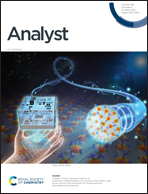A novel dehydroabietic acid-based multifunctional fluorescent probe for the detection and bioimaging of Cu2+/Zn2+/ClO−†
Abstract
A multifunctional dehydroabietic acid-based fluorescent probe (CPS) was designed and synthesized by introducing the 2,6-bis(1H-benzo[d]imidazol-2-yl)phenol fluorophore. The probe CPS could selectively recognize Cu2+, Zn2+ and ClO− ions from other analytes, and it showed fluorescence quenching behavior toward Cu2+ and a ratiometric response to Zn2+ and ClO− by changing from green fluorescence to blue and cyan, respectively. The detection limits toward Cu2+, Zn2+ and ClO− ions were 3.8 nM, 0.253 μM and 0.452 μM, respectively. In addition, CPS presented many fascinating merits, such as high selectivity, a short response time (15–20 s), a wide pH range (3–10) and high photostability. The sensing mechanisms of CPS were verified by 1H-NMR, ESI-MS, FT-IR and Job's plot methods. Meanwhile, CPS exhibited satisfactory detection performance in water samples. More importantly, the probe could be applied as a promising tool for visual bioimaging of three ions in living cells and zebrafishes.



 Please wait while we load your content...
Please wait while we load your content...